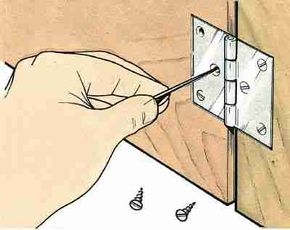Doors, like windows, stick for a number of reasons -- from poor construction to extreme humidity. In most cases, it's easy to unstick a stubborn door. To diagnose the problem, close the door, watching it carefully to locate the binding point.
If there's a gap between the door and the frame opposite the binding edge, the hinges probably need adjustment. If you can't see a gap anywhere between the door and the frame and you had to slam the door to close it, the wood has probably swollen from extreme humidity. If the hinges and the wood are both in good shape, the door frame itself may be out of alignment; check the frame with a carpenters' square. Once you know the problem, you are ready to find the best home improvement solution listed below.
Advertisement
To fix a door with poorly adjusted hinges, examine the hinges for loose screws, both on the door and on the frame. Securely tighten any loose screws. If a screw doesn't tighten, the screw hole has become enlarged. When the hole is only slightly enlarged, you may be able to correct the problem by replacing the screw with a longer one, but make sure the head is the same size.
Another option is to use a hollow fiber plug with the old screw. To do this, spread carpenters' glue on the outside of the plug, and insert the fiber plug into the enlarged screw hole. Then drive the screw into the hole. If the screw hole is badly enlarged, you can use wood toothpicks to fill it in. Loose hinge screws can also be tightened by filling the hole with wooden toothpicks dipped in glue and trimmed flush. Dip the toothpicks into carpenters' glue and insert them around the screw hole. Let the glue dry, then trim the toothpicks flush with the surface. When you drive the screw into the filled-in hole, it should hold securely.
If the screws are not loose, the hinges may have to be readjusted on the door frame. Close the door, watching to see where it sticks and where it gaps. If the door is tilted in the frame, it will stick at the top on one side and at the bottom on the other, and there will be a gap between the door and the frame opposite each binding point. If the door hinges need shimming, open the door as far as it will go. Push a wedge under it to hold it firmly.
At the hinge to be adjusted, loosen the screws from the hinge leaf on the door frame, but don't touch the screws in the door itself. Cut a piece of thin cardboard to the same size as the hinge leaf, and mark the location of the hinge screws on it. Cut horizontal slots in the shim to fit over the screws; slide the shim over the screws behind the loosened hinge leaf. Keeping the shim in place, tighten the screws to resecure the hinge. Remove the wedge holding the door and close the door. If the door still sticks, but not as much as it did before, add another shim under the hinge.
If the door sticks even after shimming, or if there is no gap anywhere around the frame, you'll have to remove some wood at the binding points. Use a block plane on the top or bottom of the door or a jack plane to work on the side. If the door sticks at the sides, try to plane only on the hinge side; the latch side is beveled slightly, and planing could damage the bevel. Use the plane carefully, removing only a little wood at a time. Keep your cuts even across the entire binding edge.
If the door sticks because the frame is out of alignment, there's not much you can do to fix it. At the binding point, set a piece of 2x4 flat against the frame, and give it several firm hammer blows. This may move the frame just enough to solve the problem. If this doesn't work, you'll have to adjust the hinges or plane the edges to allow for the unevenness of the frame. The door may end up slightly crooked, but it won't stick.
©Publications International, Ltd.
Advertisement
